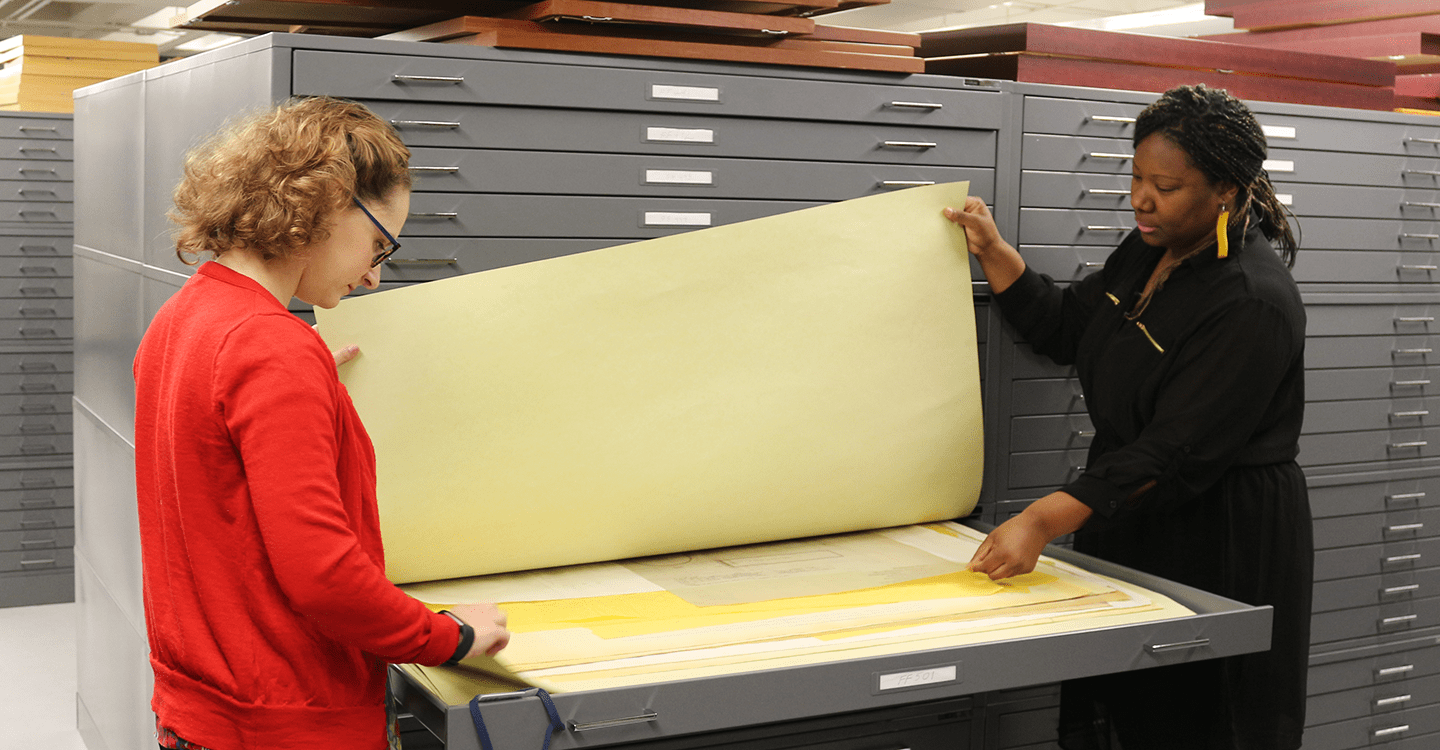
Leah and Felicia working in the stacks, aka specialized storage spaces for preserving documents and images.
What is an archivist? What does an archivist do? Do they rescue artifacts like Indiana Jones? We hear these question a lot. So let’s clarify a few things. First and foremost, our job is to preserve material culture and to make it available for now and future researchers. Our goal for our collections is threefold: to arrange them logically, to describe them accurately and concisely, and to protect them against wear and tear. We call all of these goals ‘processing’, and it is the core of our work as archivist.
You may ask, how do we keep our materials safe while simultaneously making them available to the public? Unfortunately, there is no simple answer. Each project involves different levels of managing resources and documenting their historical context for accessibility. Some collections must be recorded as a single item, whereas others are only recorded in groups – some large and some small. Despite the disparateness, we base our procedures on industry best practices and the purposeful use of technology.
Second, an archivist is an information professional, a type of librarian. We care for and catalog primary source materials that come to the Kenan Research Center. We collect a wide range of items, including, but not limited to, correspondence, newspapers, scrapbooks, photographs, videos, interviews, maps, and architectural drawings.
That’s a lot of stuff! How do we tackle each project? Well, we start each project by reviewing the donation and asking important questions. How many boxes of material is it? Are there more manuscripts or photographs? Are the materials in decent condition or are they falling apart?
Next, we divide up the visual material from the manuscripts because they are managed and preserved separately. Then, we decide whether or not there is any obvious arrangement already in place for organization. If we are lucky and the donor had a system, we try to maintain this original order. For example, one box could have business documents and a second could have family documents, and we would keep this division.
If we are not so lucky, than we must decide how the materials should be rearranged to be most useful to researchers. Groupings can be based on type of material, subject matter, purpose, the person associated with the material, by dates, or by any other system that fits with the collection.
As we reorder the papers, we also take preservation measures. Crumpled or folded paper is smoothed out to avoid tearing, rusty metal like staples and paper clips that can cause paper disintegration are carefully removed, and acid free folders and boxes are used for storage to prevent paper discoloration over time.
Anyone who has ever collected family papers has probably noticed that newspaper always turns yellow and falls apart. Fun fact: newspapers published before 1850 were actually printed on much higher quality paper (made from rags) and can last for centuries. In contrast, modern newsprint typically only lasts 50 years. To prevent losing this content, we photocopy articles onto acid-free paper.
When we are done arranging and preserving a collections, we move onto describing it. We do so by creating finding aids and catalog records. Like most archives, we base our finding aids on the Society of American Archivists’ protocol, Describing Archives: A Content Standard (commonly called DACS). And we catalog our library records using the American Library Association’s protocol, Resource Description and Access (RDA). Sometimes we are also able to digitize part or all of a collection and publish the digital surrogates in the finding aids or on Album in order to provide researchers access to resources online.
As you can imagine, organizing, preserving, and describing collections can be very time consuming. On one hand, that means that we have a backlog of material that has not been processed. On the other hand, we are fortunate to receive many fascinating and important donations that help document Atlanta’s history, so there is always more exciting work to accomplish!